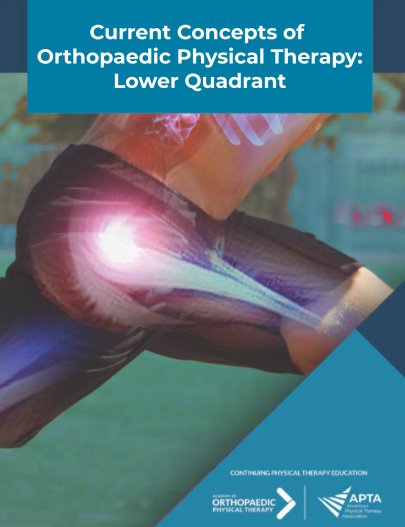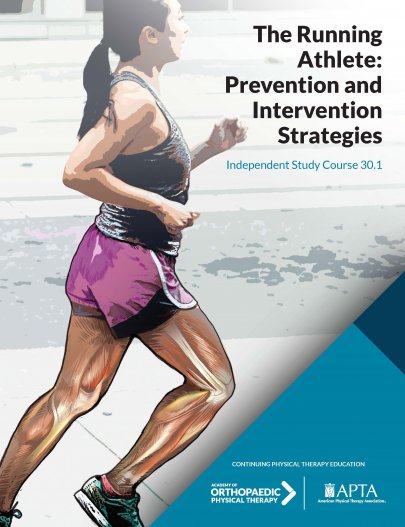Physical Therapy Approaches to the Lower Quarter
Contact Hours: 0
| Online Only | |
|---|---|
| APTA Orthopedics Member | $65 |
| Non-APTA Orthopedics Member | $115 |
Note: CEUs are not offered for this course.
Course Description
This course applies a movement systems approach to understanding the examination and treatment of lower extremity conditions. This approach highlights the anatomical and kinesiological basis to understanding how movement is the key to diagnosing and treating conditions seen by the physical therapist. Special emphasis is dedicated to the relationship between pain and movement and also the role applying the movement systems approach can have on compliance and outcomes.
Course Overview
Course Format: Online
Free Preview
Click here for a free preview of this course.
Course Objectives
- Identify adaptive and maladaptive behaviors and movements in the context of managing pain and challenges in understanding the relationship between movement and pain.
- Discuss the role of movement in the recovery from pain.
- Describe the importance of the key anatomical structures and kinesiology of these structures and their relationship to movement disorders and patterns in the hip.
- Describe a comprehensive movement system examination process of the hip.
- Develop a plan of care for movement system diagnoses of the hip based upon patient specific examination results.
- Apply performance and recruitment strategies of the muscles at and around the hip to develop movement system diagnoses.
- Discuss the relationship of a movement system approach to currently accepted models of function and patient/client management.
- Describe critical elements in forming a movement system diagnosis for a person’s musculoskeletal pain condition.
- Synthesize a plan of care that applies a movement system approach to optimize the patient’s functional goals.
- Understand the value of the movement system impairment approach in the evaluation and treatment of tibiofemoral and patellofemoral pain conditions.
- Understand key findings associated with each diagnosis, such as posture, muscle length, muscle strength, movement patterns, and structural variations.
- Identify medical diagnoses and possible referral signs that may be associated with each movement system impairment diagnosis.
- Determine the appropriate movement system impairment diagnosis and devise an appropriate treatment plan.
- Apply key anatomical concepts of the foot and ankle as they relate to movement, injury, and function.
- Understand the advantages/uniqueness of the movement system impairment approach in the evaluation and treatment of foot and ankle conditions.
- Identify key tests/signs associated with each movement pattern during examination of the foot and ankle.
- Determine an appropriate movement system impairment diagnosis and devise an individualized treatment plan for foot and ankle conditions through case examples.
- Understand the strengths and weaknesses of common outcome tools and these tools to the movement systems approach.
- Incorporate data from the biopsychosocial model of functioning and disability to impact adherence into interventions and effective and efficient outcomes specific to the patient.
- Use optimal dosage parameters and progression to maximize adherence and effective and efficient outcomes, including patient education, to achieve and sustain their desired movement outcomes.
Topics and Authors
- The Relationship Between Movement and Pain
Elizabeth Bloom, PT, DPT - Role of a Movement System Approach in Physical Therapy Management of Musculoskeletal Pain
Carrie Hall, PT, MHS; Diane D. Allen, PT, PhD - A Movement System Approach to the Hip
Carrie Hall, PT, MHS - Movement Systems Impairment Approach to Diagnosis and Treatment of Knee Pain
Sylvia L. Czuppon, PT, DPT, OCS; Suzanne L. Cornbleet, PT, DPT; Gregory Holtzman, PT, DPT, SCS - Movement Systems Approach to Classification and Treatment of the Foot and Ankle
Judy Gelber PT, DPT, OCS - Strategies for Optimizing Sustainable Therapeutic Outcomes Related to the Treatment of the Movement System
Lori Thein Brody, PT, PhD, SCS
Customers Frequently Viewed
Videos
Add To Cart
Which version of the course would you like to purchase?
Members Only
You need to be a member to buy this course.
Join today to enjoy exclusive deals and prices on all courses.
Join Now

